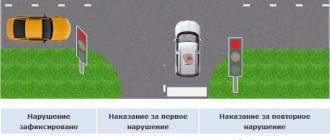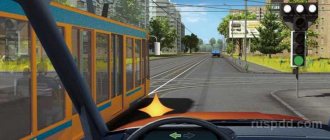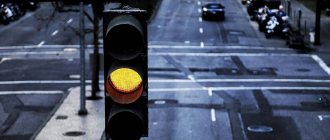A car is about speed, but some drivers have a desire to drive faster than others, and they use special signals. But the siren, flashing lights and other special signs are intended for services that rush to help people in trouble. And therefore, their unauthorized use is prohibited by the Code of Administrative Offenses, as well as refusal to let a car with a special signal pass.
In this article:
What is considered a special signal?
Cars of emergency or simply special services are distinguished by light, color icons, and sound, which they do not have
other vehicles:
- flashing lights in blue and other possible colors;
- siren or “quack”;
- light-signal beams (flashing lights);
- flash lights;
- colored and reflective stripes;
- strobes;
- loudspeakers.
They are installed so that other motorists can see special vehicles and provide them with the opportunity to drive faster.
GOST for special signals
GOST for special signals used in Russia is numbered R 50574-2002. It regulates the appearance of the lights of emergency vehicles (police, fire departments, ambulances, military inspection, FSB, Investigative Committee). The standard also dictates the types of permitted sound signals, as well as color schemes applied to special vehicles.
GOST does not affect the use of yellow flashing lights installed on trucks or equipment for road construction and repair work. This is another confirmation that they are not special signals.
Who has the right to drive with a flashing light?
The following cars have the right to drive with their flashing lights on:
- ambulance, if they are rushing to respond to a call or transporting a patient to the hospital;
- police when going on a mission;
- fire service when they go to extinguish;
- military police;
- Ministry of Emergency Situations, if the vehicle is traveling to carry out rescue operations;
- FSO, FSB, SK, for whatever purposes they are used;
- National Guard.
Types of cars with special signals
In Russia, State Duma deputies and members of the Federation Council, ministers, and governors can also drive with flashing lights. The list is determined by Presidential Decree N635 of May 19, 2012.
Responsibilities of drivers when an ambulance appears
If drivers of ordinary vehicles notice an ambulance on the road, which is in a hurry to respond to a call, indicating their intentions with special signals turned on, they must be guided by paragraph 2 of section 3 of the Traffic Rules.
In particular, this section of the rules instructs them to give way to the approaching ambulance crew in order to ensure that they can pass unhindered along the chosen trajectory. In addition, paragraph 3 of this section instructs the driver to be careful when approaching an ambulance that is standing on the road with the flashing light and siren turned on. In this situation, the driver of an ordinary vehicle must slow down so much that if the ambulance starts moving, he can immediately clear its path or stop.
Thus, in some cases, the Ambulance is indeed given the right to legally violate the requirements of traffic rules. And drivers who are forced to give way to her should remember that the crew is rushing to help the injured people.
Certificate for special signals
For each driver working in the police or other emergency services, a special type of certificate is issued - for special signals. The document is issued after completing training courses at an educational institution that has a special license.
Drivers of special services, among other things, must master the skills of extreme driving, the use of radio communications, and special signals. After a full-time or part-time course, they take an exam, and only then receive a document for permission to work. The certificate is valid for a maximum of 5 years, after which retraining is required. All this is carried out in accordance with Decree of the Government of the Russian Federation No. 876 of 2007.
As for permits for the use of special equipment for cars, their issuance is regulated by Order of the Ministry of Internal Affairs No. 167 of 2007. It states that:
- permission to install and use white beacons is given to Russian Post, collectors and vehicles transporting valuable cargo;
- the possibility of using yellow and orange light devices is available for road equipment and vehicles with dangerous, oversized cargo, buses transporting children in an organized manner;
- permission to use blue and red beacons, as well as the devices themselves, are issued only by the Ministry of Internal Affairs of the Russian Federation.
That is, if there are grounds, you can install a white or yellow light signal on the car. But for red or blue you need a special permit.
What are the advantages of vehicles with yellow and orange flashing lights?
Special vehicles of various services can be equipped not only with standard blue and red flashing lights. Very often on the road you can see cars with yellow beacons, which are used to perform a wide range of tasks. They can be seen on construction equipment, tractors, tow trucks and tractor-trailers. Why do vehicles need lights of this type and do other road users have the right to overtake them?
There is no clause in the Rules that would oblige other road users to let vehicles with yellow lights pass
The first step is to answer the question: who can use yellow beacons? The answer to this can be found in paragraph 4 of Article 3 of the Traffic Regulations. It is indicated here that a yellow or orange flashing light can be used in the following cases: 1) when performing construction, repair or maintenance work on roads, as well as when loading damaged, faulty and moving vehicles; 2) when transporting large cargo, explosives, flammable and reactive substances, as well as toxic substances with a high degree of danger; 3) when accompanying vehicles that transport large, heavy and dangerous cargo; 4) when accompanied by organized groups of cyclists; 5) during organized transportation of a group of children.
Cars with a yellow flashing light can also deviate from the marking requirements, enter the oncoming lane for maneuvers and move in the leftmost lane at any speed
It is also stated here that an illuminated yellow or orange beacon does not provide the driver with any advantage while driving and is only necessary to warn of danger. Motorists, for their part, must respond to these signals and adjust the speed and direction of movement so as not to create a danger.
Article 3 of the Traffic Regulations also states that a yellow light on the roof of a car allows you to deviate from the requirements of some signs. The only exceptions are signs 3.20 “Overtaking is prohibited”, 2.4 “Give way” and some others, which limit the weight of the trailer used. Cars with a yellow flashing light can also deviate from the marking requirements, enter the oncoming lane for maneuvers and move in the leftmost lane at any speed.
A car with a yellow flashing light, when accompanied by cyclists, can move into the oncoming lane to protect the latter from being hit by cars.
However, vehicles with yellow flashing lights cannot weave through traffic jams and demand yield. There is no clause in the Rules that would oblige other road users to let vehicles with yellow lights pass. But such transport still has advantages on the road. For example, a car with a yellow flashing light, accompanied by a large truck that is transporting a large gas pipe, can drive into the oncoming lane and block traffic for other drivers at the moment when the truck makes a difficult maneuver. In such circumstances, a traffic jam may even form. Another example is that a car with a yellow flashing light, when accompanied by cyclists, can move into the oncoming lane to protect the latter from being hit by cars. However, such actions are permitted only after safety for other road users has been ensured.
Bottom line . Vehicles with yellow or orange flashing lights have several advantages on the road, as they may deviate from the requirements of some types of signs and markings.
The procedure for using special light and sound signals
The procedure for using special light and sound signals on public roads is regulated by clause 3 of the Traffic Regulations of the Russian Federation and is as follows:
those who have the right to a blue car beacon, if absolutely necessary, can ignore traffic lights and demand to give way to them in violation of the rules;- the same is permitted for vehicles accompanied by cars with blue or red lights;
- Special vehicles can violate traffic rules only after making sure that they are given way;
- the light signal on such a machine must be supplemented by the inclusion of sound;
- When a special vehicle approaches, other vehicles must move to the side or slow down to let it pass;
- It is prohibited to overtake emergency vehicles driving with working signals;
- if it is stationary, but the beacon and siren are on, an ordinary car should reduce speed as it approaches;
- yellow and orange beacons do not give priority in travel, but vehicles with them can, if necessary, ignore markings and road signs, except for 2.2, 2.4 - 2.6, 3.11 - 3.14, 3.17.2, 3.20;
- they may also not comply with the rules of paragraphs 9.4-9.8 and 16.1 of the traffic rules, if this does not threaten traffic safety;
- white beacons on Russian Post vehicles, collector vehicles carrying valuable cargo can be turned on only if there is a threat of attack on them;
- The cars listed in the previous paragraph do not have access rights.
More on AutoLex.Net:
How to appeal a traffic police decision on an administrative offense in 2021?
Watch this video about traffic rules when using special signals:
Survey
On October 8, the Ministry of Health on its website appealed to vehicle drivers to give way to ambulances. Getting stuck in a traffic jam, doctors lose precious time, and along with it, it happens that patients...
Employees of the Road Traffic Safety Inspectorate of the Tashkent City Internal Affairs Directorate are confident that instilling in drivers high personal responsibility and a culture of clearing the way for ambulances is a completely feasible task. But it is necessary to make efforts to solve it not only by government departments, but also by society itself.
Let’s imagine a situation in which almost all drivers find themselves at least once in their lives. Behind your car on the road you hear the sound of a siren, in the mirrors you see a service vehicle with priority travel rights with flashing lights on.
- WHAT DOES THE LAW REQUIRE?
According to the Traffic Rules, “when approaching vehicles with a blue or blue and red flashing light and a special sound signal, as well as vehicles accompanying them with low beam headlights on, drivers are required to give way to them to ensure their unhindered passage.”
In addition, “when approaching a stationary vehicle with a blue or blue and red flashing light on, the driver should reduce speed to be able to stop immediately if necessary.”
The Code of the Republic of Uzbekistan on administrative responsibility, in turn, provides for punishment in case the above-mentioned legal requirement is not taken into account. According to the first part of Article 128-5: “Creation by drivers of vehicles of interference with the passage of vehicles enjoying the right of unimpeded movement - entails a fine in the amount of five minimum wages.” A repeated offense of this kind, committed within a year after the application of an administrative penalty, entails a fine in the amount of twenty minimum wages or deprivation of the right to drive a vehicle for a period of one year.
- UNDERSTAND WHERE TO EXPECT.
When you hear the phrase “let the ambulance pass,” you will most likely remember videos from around the world where special vehicles are approaching from behind. But it is worth remembering: he may also be on the road you are crossing and has the right to pass through a prohibiting traffic light. Therefore, sometimes in order to let special vehicles pass, you don’t have to invent anything - it’s enough to slow down in advance until the car comes to a complete stop, even if you hear the siren in the distance. Naturally, you shouldn’t make sudden maneuvers - always be aware of the drivers behind you.
- COMMON EFFORT IS IMPORTANT.
If you find yourself in a dense stream of cars, your overall success depends on the coordinated actions of all road users nearby.
In world practice, special vehicles in an emergency most often move along the left lane of the road, and drivers are offered the following course of action . Everyone in the left lane moves to the left. The remaining lanes are to the right. It is important not to make sudden movements and remember that your actions matter, even if you find yourself in the far right lane - only common efforts will make it possible to build a “corridor of salvation” where a little earlier it was difficult to even imagine.
It is possible that the driver of the car on your right will become confused. Ask him for assistance - not only with the turn signal on, but also with a word (certainly polite, and at the same time audible on a noisy road).
- The condition for ensuring road safety is one of the most important. When doing something important like creating an “escape corridor,” you should, first of all, be sure to warn other drivers about the planned maneuver by turning on the turn signal. The lane change maneuver requires caution without unnecessary haste: be attentive to the fact that drivers around you are also making maneuvers at this moment.
When giving priority to traffic moving in front of you on the road you are crossing, learn to hear the siren in advance and reduce speed in advance, without creating an emergency situation - the driver behind you may not have time to react.
Having moved to the side and let special transport pass, return to your lane without unnecessary haste.
- SHOULD YOU BE AFRAID OF A FINE for a traffic violation committed by a driver in order to create an “escape corridor”? Previously, we have repeatedly devoted materials to this, but we will repeat once again: no, it’s not worth it. According to Article 271 of the Code of the Republic of Uzbekistan on administrative responsibility, proceedings in a case of an administrative offense cannot be started, and what has been started is subject to termination in the presence of circumstances, among which there is “the action of a person in a state of (...) extreme necessity.” Therefore, even if a traffic violation (for example, crossing a stop line or a solid marking line) is recorded by automatic recording cameras, the decision to impose a fine is subject to cancellation.
“This concerns me too” is a motto that every driver should remember as soon as they hear the siren. Sooner or later, an ambulance, a police car or a fire department will rush to your home and to your family. Imagine that the drivers on their way will not give way, or will give way, but not all of them. Change the consciousness of those around you with your own actions today - create a corridor of salvation and learn to hear the siren where you previously ignored it.
This is how drivers are trained to clear the lane for an ambulance to pass in Germany. Everything is clear and understandable without translation.
Blue flashing beacon
A blue flashing light may indicate that the vehicle belongs to:
- police or other law enforcement agency;
- Ambulance;
- fire service.
If the driver of a special vehicle needs to pass first, he must also turn on the sound signal. In the absence of a siren or quack, ordinary cars are not required to give way. If the driver does not allow the car to pass with a special signal, he faces Part 1 of Article 12.17 of the Administrative Code, that is, a warning or a fine of 500 rubles.
What is the penalty for failing to pass an ambulance in 2021?
Not long ago, a number of amendments were made to the law on preventing the passage of ambulances, and if previously the insignificance of the punishment entailed frequent violations, today it is unlikely that anyone will risk deliberately obstructing a car with special signals.
Starting this year, there are two types of liability for failure to pass an ambulance, depending on the consequences:
- Administrative. Provides two options for punishment: a fine from 3 to 5 thousand rubles or deprivation of driving rights for a period of 3 months. up to 1 year (Article 12.17 of the Administrative Code). Such measures are applicable if the act did not significantly affect the patient’s health. For comparison: previously a fine of 500 rubles was expected for such an offense. and deprivation of the right to drive a vehicle for a maximum of 3 months.
- Criminal. Here, the severity of the punishment depends on the degree of harm caused to the patient due to the actions of the driver who did not give way to the ambulance:
- forced labor, restriction of freedom for up to 2 years or a fine of up to 80 thousand rubles, if serious harm to health is caused,
- restriction of freedom for up to 4 years, if the patient died due to the negligent actions of the motorist.
Such amendments to the law were caused by several high-profile cases when, due to the actions of car owners, patients in medical vehicles died because they did not manage to get to the hospital on time.
Lawyers believe that the law is somewhat flawed, because in the event of a patient’s death, it is quite difficult to say what exactly was the cause - the actions of the driver or the incompetence of the medical team. Most likely, some changes will be made to it.
Lunar-white flashing beacon
A white-lunar flashing light means that the car is carrying material assets and has been attacked. This signal is needed to attract the attention of the police and is a request for help. If the car is simply moving in the general flow, there is no threat of attack, the beacon is not used. And he has no advantages in travel. Like everyone else, its driver is obliged to comply with traffic rules.
The concept of "Give way"
The concept of “Give way” is given in paragraph 1.2 of the traffic rules:
“Give way (do not interfere)” is a requirement that means that a road user must not start, resume or continue moving, or carry out any maneuver if this may force other road users who have priority over him to change direction. movement or speed.
Let's take a closer look at the concept. Moreover, special attention should be paid to those actions that are prescribed to the driver. And to be even more precise - on those actions that the driver is prohibited from performing.
“Start moving” - obviously, this action only applies to the case when the car is stationary.
“Resume movement” - the action is similar to the previous one, with the only difference being that the car was in motion immediately before stopping.
“Keep moving” - this prohibition applies to vehicles that were in motion immediately before the need to give way arose. Such cars must stop.
“Perform any maneuver” —Do not perform maneuvers, such as turning or turning, that would force other road users to change direction or speed.
Why do the police have red and blue flashing lights?
The police may have red and blue flashing lights because this combination attracts
more attention than a single beacon color.
But such cars do not have any additional privileges, other than those established in clause 3 of the traffic rules. They give way if the light accompaniment is complemented by sound. In this case, ordinary cars must allow special vehicles to turn around, turn, drive in reverse, etc.
About the advantages of “yellow flashing lights” - whether you need to give way to them, whether you can overtake or not
Let's talk about yellow and orange flashing lights: is it possible to overtake them, how to give way, and whether there are fines for “not allowing” cars with such flashing lights to pass.
* Yellow and orange flashers are essentially the same in function. For brevity, we will write “yellow” everywhere.
Cars with yellow flashing lights DO NOT HAVE ANY ADVANTAGES over other road users.
according to article 3.4 of the traffic rules:
“An illuminated yellow or orange flashing light does not provide an advantage in traffic and serves to warn other road users of the danger.”
That's why
1. Overtake
cars with yellow flashing lights
POSSIBLE
2. Give way
cars with yellow flashing lights
do NOT have to
3. No fines
NO
for “incorrect” interaction with cars with yellow lights . That is, no one will fine you if you overtake or do not give way to such a car.
BUT! It is imperative and adequate to react to yellow flashing lights.
The yellow lights on make it clear that there is an unusual situation on the road - repairs, a convoy of cyclists, a tractor dragging a large load and blocking most of the road... Therefore, the driver must be ready to adjust the speed, trajectory, or resort to an emergency stop.
We list the cases when yellow flashing lights must be turned on (according to paragraph 3.4 of the traffic rules): - during construction, repair, maintenance of roads using construction equipment, tractors, etc., for example, when clearing roads of snow - when loading vehicles on a tow truck - on tractors and trucks when transporting large cargo or hazardous substances (radioactive, explosives, etc.) - on vehicles that accompany a convoy of cyclists - on buses that transport groups of children.
That is, all cases are logical and giving way to, for example, a snowplow is an adequate reaction of any driver.
In addition, the turned on yellow flashing lights cancel the effect of some signs and special vehicles with the turned on yellow light on the roof can legally deviate from some traffic rules.
For example, stopping in prohibited places, driving into oncoming traffic to maneuver, driving at a minimum speed in the leftmost lane, etc. All cases are prescribed in paragraph 3.5 of the traffic rules. So caution doesn't hurt in any case.
As for the “rules of behavior” with cars with blue and blue-red flashing lights, we discussed them in the articles
“In what cases and how to yield to cars with blue flashing lights”
“Is it possible to overtake an ambulance or fire department with flashing lights on?”
“Is it possible to overtake a traffic police car with flashing lights on”
Do I need a permit for a yellow flashing light?
There is no special need to obtain permission for a yellow flashing light. If a driver in his car has to perform work that requires such a beacon, the device is simply purchased at the store and installed.
There is no point in using it just like that. A yellow flashing light does not provide any special advantages on the road. Only vehicles involved in road repairs can ignore the markings, and when clearing roads from snow, they can perform maneuvers where others cannot. But here we are talking about special equipment that has a corresponding appearance. And installing a yellow flashing light on a regular car will not protect its driver from punishment for violating traffic rules.
What is the fine for special signals in 2021
The Code of Administrative Offenses of the Russian Federation is responsible for regulating the requirements related to the installation of special signals, namely: Article 12.4, paragraphs 1-2 and Article 12.5, paragraphs 3-5. Let's look at each of the penalties for using special signals in more detail.
- 12.4, part 1
It is possible to receive a fine for flashing lights even if the car was parked in a garage and was not in use.
What is the penalty for violation?
Attaching a special signal to an ordinary car misleads other people, provokes chaos on the road, and creates an increased threat. Therefore, the act is punishable by monetary payment or deprivation of rights.
For unauthorized installation and use on a car
There is a ban on installing special signals on a regular vehicle in the Code of Administrative Offences. Sanctions for this are reflected in section 12.4, more precisely in its 2nd and 3rd parts:
if a motorist has installed signs of operational organizations on his car or those that have the right to be only on a taxi, a disabled person’s vehicle, he will have to pay 5,000 rubles for this;- the same violation, but committed by an official, is punishable by a fine of 20,000 rubles;
- a similar offense in which a legal entity is involved will result in the payment to them of 500,000 rubles.
And in each of the above cases, inappropriate distinctive items will be confiscated. It is prohibited to make an ordinary car look like a police car, a cash-in-transit car, a fire truck, or an ambulance. But section 12.4 of the Code of Administrative Offenses concerns only cases of installation of special signals. That is, it can also be applied when the motorist has not turned on prohibited devices.
More on AutoLex.Net:
It is possible that you will be deprived of your license for not having a child car seat.
Driving in vehicles with illegally installed and operating special signals is punishable in accordance with Section 12.5 of the Code:
- a motorist driving a vehicle with the designation “disabled” or the external elements of a passenger taxi will pay 5,000 rubles to the budget;
- for driving a car, the body of which is decorated with color stripes like a special service vehicle, you will have to do without a driving license for up to 1.5 years;
- Driving a car with light and sound elements turned on, corresponding to those found on emergency services and law enforcement vehicles, will result in the driver being left without a driver's license.
Applying colored elements to the body, simulating vehicles of special organizations, and driving a painted car will lead to the requirement to submit a license for the same period of time. In all of the above cases, special signals will be confiscated.
For information on fines when installing special signals on vehicles, watch this video:
For not allowing a car with special signals to pass
According to the law, police, traffic police, ambulance, fire service vehicles, as well as those belonging to government agencies, should be allowed through if they are driving with their special lights on. But not all drivers of personal vehicles do this. Such a violation can lead to tragedy and is therefore punishable. There is section 12.17 (part 2) about it:
Failure to provide priority in movement to a vehicle that has special color schemes, inscriptions and designations applied to the outer surfaces, with a blue flashing light and a special sound signal simultaneously turned on, entails a fine of five hundred rubles and deprivation of the right to drive the vehicle for a period of one to three months.
We are talking about ambulances, police vehicles, traffic police, and fire departments. These sanctions have been determined at the moment. But a draft amendment has been submitted to the State Duma, according to which it is proposed to fine drivers who do not allow special transport to pass by 30,000 rubles.
To learn about increasing liability for not allowing cars with special signals to pass, watch this video:
Penalty for strobe lights
The fine for stroboscopes installed on a car is imposed under Part 1 of Article 12.4 of the Code of Administrative Offenses and amounts to 3,000 rubles. After the vehicle is seized by an inspector, the devices are confiscated. The color and operating mode of the luminous devices do not matter. And the fine for white strobes will be the same as for red or blue ones. After all, with them, transport ceases to comply with the “Basic provisions for the admission of vehicles to operation...”.
The same fine applies to strobe lights in the cabin installed under the windshield or in another place. In these cases, unnecessary parts also make the car non-compliant with the regulations. True, punishment will be avoided with a greater degree of probability. After all, traffic police officers do not have the right to inspect a car without a good reason. Otherwise, it is unlikely that it will be possible to detect the lighting devices; after seeing a policeman, the driver can quickly turn them off.
And yet, you shouldn’t risk installing unnecessary parts even in the interior. When turned on, they are distracting and make operating the machine more tedious, which reduces safety.
Therefore, sanctions for similar things exist in other countries. For example, the fine for strobe lights in Kazakhstan is 15 times the minimum wage. You cannot use unnecessary lighting devices on your car or near your neighbors. The fine for strobe lights in Ukraine is several thousand hryvnia.
Fine for yellow flashing lights
A driver may be fined for having a yellow flashing light if he is required to use it by law, but there is no light device on the car, or it is not turned on. It is imposed if:
- Transport carries dangerous, large cargo or accompanies it, participates in the repair or cleaning of the road, and the evacuation of other vehicles. In these cases, the payment will be 500 rubles. under Article 12.20 of the Code of Administrative Offences.
- Transport is used for organized transportation of children. If there is no flashing light on the bus, the penalty is imposed under Part 4 of Article 12.23 of the Code, this is a fine of 3,000 rubles.
There is no special sanction in the law for the use of a yellow light signal. But if the car does not perform any of the types of work for which the device is required, but it is still there, they will be punished at least under Part 1 of Article 12.4 for 3000 rubles. Responsibility for a yellow flashing light, if the driver is driving such a car, is imposed under Part 3 of Article 12.5. That is, he will be deprived of his rights for 6-12 months.
Fine for “quack”
The fine for a police “quack” is imposed under Part 2 of Article 12.4 of the Code of Administrative Offenses:
Installation on a vehicle without the appropriate permission of devices for giving special light or sound signals (with the exception of security alarms) ... entails the imposition of an administrative fine on citizens in the amount of five thousand rubles with confiscation of the subject of the administrative offense ...
It is only due to the fact that the device is on the machine, but is not used. Traffic police officers conduct raids to identify such cars, and it is very easy to fall under this article. If the driver turned on the “quack”, he will be punished under Part 4 of Article 12.5 of the Administrative Code:
Driving a vehicle on which devices for sending special light or sound signals (with the exception of security alarms) are installed without the appropriate permit shall entail deprivation of the right to drive vehicles for a period of one to one and a half years with confiscation of these devices.
Cars can be used as mobile advertising, in which case a loudspeaker is sometimes required. But permission for SGU should be obtained from the traffic police. Installing a device is a change to the design of the car and is formalized accordingly. The registration document must contain a record of its availability and a description of the type of device.
More on AutoLex.Net:
Fine for parking on the lawn: what is the punishment in 2021 and where to complain
Fine for flashing beacon
The fine for an illegally installed flashing light is:
- 3000 rub. and is imposed under Part 1 of Part 12.4 if the device is yellow;
- 5000 rub. and is issued under Part 3 of the same article, if it is the same as for the police, ambulance or Ministry of Emergency Situations.
That is, the fine for a blue or red-blue flashing light is 5,000 rubles, and for a yellow or orange one – 3,000 rubles.
If a driver turns on illegally installed signal lights on the road, it will cost him even more:
The use of devices for producing special light or sound signals (with the exception of security alarms) installed without the appropriate permission while driving a vehicle entails deprivation of the right to drive vehicles for a period of one and a half to two years with confiscation of these devices.
Fine for beeping in the city
A fine for an unreasonable sound signal in the city can be issued under Article 12.20 of the Code of Administrative Offences, it will amount to 500 rubles. Drivers manage to get away with a written warning. Similarly, a fine is imposed for honking in a residential area, where there is no need to sound the car horn at all, and such a driver’s action brings a lot of inconvenience to many people at once.
The article of the Code of Administrative Offenses does not mean that honking within the city is completely prohibited. Sound is used to warn other road users of danger. If it’s not there, don’t needlessly scare passers-by.
There is also a fine for a non-functioning sound signal - 500 rubles. according to Part 1 of Art. 12.5 Code of Administrative Offences. Here, too, you can get by with a warning from a traffic police officer.
How to let special vehicles through
This situation can happen anywhere. But in big cities, and primarily in megacities with a population of over a million, the probability is much higher. At the same time, public opinion, as a rule, sides with special transport - especially if it is an ambulance or a special vehicle of the Ministry of Emergency Situations. And everything would be fine, but sometimes, in order to give way to a special vehicle, you need to... violate traffic rules. What to do in this case?
At the end of last year, the news showed another video from the “doesn’t let the ambulance pass” series, where the driver of a far from cool Mercedes is driving in the left lane of the Lefortovo Tunnel in Moscow. And although the rows to the right are also occupied by cars, you can turn on the turn signal and move into the adjacent lane if you wish. However, the Mercedes continues to drive straight - faster than the next row, but clearly slower than the ambulance required.
In this case, the rudeness of the Mercedes driver is obvious. Despite the fact that later, during interrogation by the police, he referred to the continuous markings, which did not allow him to move aside, at the end of the video it is clearly visible that Mercedes is in no hurry to clear the passage even after the solid markings are replaced by intermittent ones.
There is a legal conflict here: situations can arise (and regularly arise!) on the road when, in order to let an ambulance pass, it is necessary to violate other traffic rules. And messages regularly appear on the Internet about how drivers are fined for such violations.
One example of punishment for a good deed. In this situation, the picture even shows an ambulance moving in the left lane
There are two typical scenarios for forced violations when passing special vehicles: changing lanes across a solid marking line (if it happens while moving) and driving beyond the stop line (when the ambulance catches up with the “violator” standing in front of a prohibitory traffic light). There may be other situations when the requirement to let one through forces one to violate (for example, reversing where it is prohibited, or driving onto the sidewalk to clear the passage...), but the essence here remains the same: it is not always possible to let one pass without violating other traffic rules requirements.
What provisions of the Rules regulate the driver’s obligation to let special vehicles pass?
The clause regulating the driver’s actions in relation to special vehicles is not in the section of the driver’s duties, but in the section on the use of special signals. This is paragraph 3.2 of the traffic rules, which states: “When approaching a vehicle with a blue flashing light and a special sound signal on, drivers are required to give way to ensure unhindered passage of the specified vehicle”...
In turn, drivers of special transport are required to follow clause 3.1 : “Drivers of vehicles with a blue flashing light on, when performing an urgent official task, may deviate from the requirements of sections 6 (except for traffic controller signals) and 8–18 of these Rules, appendices 1 and 2 hereto Rules provided that traffic safety is ensured.
To gain an advantage over other road users, drivers of such vehicles must turn on a blue flashing light and a special sound signal. They can take advantage of priority only by making sure that they are given way”...
So what to do if it is impossible not to break?
We decided to ask this question directly to the traffic police, using the feedback form on the official website, in order to receive the most independent answer possible, not “tailored” specifically for the media. And this is what they answered us:
As you can see, the traffic police recognizes that the current version of the traffic rules does not regulate such a situation in any way. However, part 1 of Article 24.5 of the Code of Administrative Offenses of the Russian Federation provides for cases in which a driver may be released from punishment for traffic violations in the absence of an event or corpus delicti of an administrative offense, as well as when performing actions in a state of emergency and other circumstances provided for by the Code. Thus, the driver, according to Chapter 30 of the Code of Administrative Offenses of the Russian Federation, can appeal a fine received as a result of passing special vehicles. The main thing here is the presence of evidence that one’s actions were forced. It’s good if you have a video recorder - it will allow you to clearly prove the need for a violation. If there is no registrar, then there is only one piece of advice: do not miss the same ambulance too much in advance. The special vehicle must be in close proximity to your car so that both vehicles are captured by the video camera of the violation - as in the photo above: in that case, the fine issued to the owner was canceled. Yes, an appeal will require time and a personal visit to the traffic police department (the ability to appeal traffic police fines via the Internet has not yet been launched), but your conscience will definitely be clear: you did everything possible to save someone’s life!
How to challenge a fine for an involuntary violation?
We have already talked about how you can challenge an unreasonable fine. Therefore, now we will simply briefly recall the algorithm of actions.
- Write a corresponding complaint and send it to the agency that issued the decision by mail or bring it in person. The complaint must indicate the number of the resolution, as well as state your own interpretation of the events and note the presence of evidence (photos, videos or witness statements).
- You can challenge a fine within ten days after the decision on an administrative offense is issued. But even if the deadline is missed, you can additionally draw up a petition to restore the missed deadline for appealing the decision. If there are good reasons, your request will be granted.
- If the complaint is filed by a representative of the vehicle owner or his driver, a power of attorney from the vehicle owner will be required.
What happens if you don't miss it?
From August 6, 2021, a fine for failure to pass a vehicle that has special color schemes, inscriptions and designations applied to the external surfaces, with a blue flashing light and a special sound signal turned on at the same time, entails the imposition of an administrative fine in the amount of three to five thousand rubles or deprivation of the right driving vehicles for a period of three months to one year (Article 12.17 part 2 of the Code of Administrative Offenses of the Russian Federation).
In addition, if the delay of an ambulance resulted in serious harm to health or the death of a patient, the driver of the vehicle that did not allow the ambulance to pass may also be held criminally liable under Article 124.1 of the Criminal Code “Obstruction of medical care.”
However, these sanctions are applicable only for failure to pass special vehicles in the appropriate livery. For failure to pass a “civilian” vehicle with a flashing light, only a fine of 500 rubles is provided (Article 12.17 Part 1 of the Code of Administrative Offenses of the Russian Federation). In other words, if you do not give way to an official’s Mercedes, you will not face deprivation. And it is right! - after all, even if an offended “servant of the people” or a people’s deputy wants to “punish” an unyielding driver, this punishment is significantly less than the fine for, for example, being forced to cross a solid marking line or driving beyond the stop line.
If we ignore the moral component, then even the most cynic will easily calculate that the fine for not allowing an ambulance to pass is much greater than the fine for changing lanes across a continuous lane. But special vehicles must be allowed through without any calculations - just humanely. Unconditionally. Regardless of whether you can do this without forced violations or not. The life, health and safety of a person is more important than any fine.
FAQ
The topic of illegal attachments on a car is not so simple, there is something unclear in it:
This is stated in article 12.4. The owner will pay 5,000 rubles for violation.
If special signals are installed and applied to the car body, but it is parked in a garage, can the owner be fined?- If a driver on the road turns on a police flasher, but the car looks normal and has no stripes, is this a violation of the law? Yes, he will pay for the offense by losing his driver's license.
- Can traffic police officers simultaneously demand that you pay a fine and give up your license if you have illegal special signals and are driving such a car? Yes, these are punishments for the fact that prohibited devices are installed (fine) and for their use while moving (deprivation of driving license). After all, there are two violations here.
- Is there a chance to avoid punishment for not allowing special transport to pass? Theoretically, this is possible. You can try to prove that the deputy’s car or police car did not turn on a special signal, that is, it did not actually demand to let it pass. It will be possible to avoid sanctions in cases where it was physically impossible to give way.
Another way is to prove that the operational service employees turned on the special signal illegally, that is, while traveling not on official business, but on personal business. But this is very problematic; only a good lawyer can handle this, and not always.
The use of illegal lighting, visual and sound devices is not necessary. This is a whim of a car enthusiast, for which he can become a pedestrian for a long time. Therefore, you should not even try to install special signals, so as not to create problems for yourself and traffic.
How will the driver’s dispute with the traffic police over an ambulance end?
The confrontation between Togliatti driver Viktor Allin and the local State Traffic Inspectorate, brought to the point of absurdity, can be safely resolved in favor of common sense. The traffic police department of the Samara region is ready to cancel the fine for the driver who violated the most important traffic rule in an attempt to give way to an ambulance.
The incident occurred in Togliatti, at the intersection of Frunze Street and Marshal Zhukov Street. Victor, as befits a responsible driver, stopped in front of the pedestrian crossing when the traffic light turned red. While waiting for the green signal, he saw an ambulance from behind, driving between two lanes, honking and flashing its lights.
Victor realized that he should let the doctors rush to respond to an urgent call. In order to move his vehicle, he had to drive a little forward, as a result of which the front wheels drove over the stop line. Drivers of neighboring cars performed a similar maneuver. One of them also drove over the solid line - he probably also received a fine.
Photo courtesy of Victor Allin
“All the cars made way, and I also moved forward and to the left so that the ambulance could pass,” Victor told News.ru. The incident was captured by a camera located above the road, and on August 9, Victor was given a fine of 800 rubles. The amount is not that significant, but it is offensive: after all, the driver crossed the stop line not out of inattention or malice, but with the best of intentions.
“Actually, I expected the fine to come. I knew that there were cameras at the intersection, but I couldn’t help but let the ambulance pass,” Victor said in a commentary to News.ru. He wrote a complaint on the traffic police website, but his arguments were ignored. In the document signed by the acting the head of the Center for Automated Recording of Administrative Offenses of the Regional Directorate of the State Traffic Safety Inspectorate, Evgeniy Magsumovich Shaidullin (available to News.ru), says that Victor should have “taken such a position in advance to ensure unhindered passage for this vehicle, as well as the vehicles accompanying it.”
At the same time, Victor stated that he had already dealt with the fine. “I have neither the desire nor the time to travel to the courts because of this, so I paid for it. For the first twenty days you can pay for it with a 50% discount, I paid 400 rubles,” he said in an interview with News.ru. “I don’t quite understand this decision. I couldn't change lanes in advance because by the time I saw the ambulance, I had already been at the traffic light for about forty seconds. I couldn’t predict in advance that she would appear,” Victor is perplexed.
Courtesy of Victor Allin
“A driver, while driving in a busy city, cannot, of course, take into account the possibility of an ambulance appearing at every stop at an intersection,” Evgeniy Grek, a representative of the taxi drivers’ union, stated in an interview with News.ru. He drew attention to the fact that the legislation does not specifically regulate the rules of conduct in such a controversial situation. And we’re not just talking about moments when you need to miss an ambulance.
For example, if a taxi driver drops off a disabled passenger at a special parking lot intended only for this category of citizens, he may also face a fine, since the taxi is not included in a special register where cars of people with disabilities are included. “The only thing left is to either drop off the passenger two kilometers from the place he needs and create unnecessary difficulties for him, or pay later,” complains Evgeniy. However, in his opinion, the driver should let the ambulance pass in any case, so that the doctors have time to arrive on time to the call: saving a human life is more important than any fines.
Many social network users also supported Tolyatti resident Viktor Allin.
vk.com/inzidentmiass
vk.com/life_samara
vk.com/inzidentmiass
vk.com/life_samara
It is noteworthy that if the driver does not give way to an ambulance rushing to call, he will also face a fine or deprivation of the right to drive a vehicle for a period of 1 to 3 months (Article 12.17 of the Code of Administrative Offenses of the Russian Federation). But when passing doctors, it is important not to overdo it, so as not to create an emergency situation for other road users.
“No one expects a driver to lift his car in a helicopter or run a red light,” Alexander Kaminsky, a representative of the Academy of Driving Skills, explained to News.ru. He pointed out that Victor Allin’s good intentions are obvious, but the camera records a violation of traffic rules absolutely impartially and the mechanical device is not aware of the situation. “Although, at the trial, I would acquit him,” the interlocutor said.
“In this case, the driver was obliged to let the ambulance pass. In this regard, and also due to the insignificance of the violation [crossing the stop line by less than half a car length, which did not create interference or an emergency situation], he should be released from liability on the basis of Articles 24.5 of the Code of Administrative Offenses and 2.9 of the Code of Administrative Offenses,” says the automobile lawyer of the public movement “STOP Illegal” Alexander Lyaskovsky.
“I think that Victor’s fine is completely unjustified,” lawyer Dmitry Sotnikov expressed his opinion in an interview with News.ru. In his opinion, Russian legislation allows such controversial fines to be appealed through the courts, but most drivers prefer not to get involved in litigation.
Posted by Victor Allin (@victorallin)Jul 2, 2021 at 9:31 PDT
True, now the money can be returned to the driver: the Samara traffic police department probably became ashamed and called Victor with a proposal to cancel the unfair punishment. “He [the State Traffic Inspectorate representative who called] told me that I need to go to court and he will petition for the traffic police to cancel the fine,” Allin said. The News.ru correspondent sent a request to the Ministry of Internal Affairs with a request to explain what happened, but there has been no response yet (the Ministry of Internal Affairs promised to send a letter to the News.ru editorial office on August 30).
Lawyer Dmitry Sotnikov advises Allin to go to court after all: only through regular lawsuits will it be possible to change law enforcement practice in the field of fines. “The court ruling will need to be carried out for execution by the traffic police. They will return the money paid as a fine to the account or debit card,” the lawyer noted in a comment to News.ru.
Let us note that what happened to Victor is by no means an isolated incident. In the same city of Tolyatti last year, driver Vyacheslav Strochenkov gave way to an ambulance and also received a fine. Then the traffic police also advised the driver to appeal the order. Unfortunately, the traffic police do not often correct their mistakes immediately. “It happens that already when submitting applications they say that we will refuse, you can sue or complain to the prosecutor’s office,” notes Evgeniy Grek.
Add our news to your favorite sources
Add










